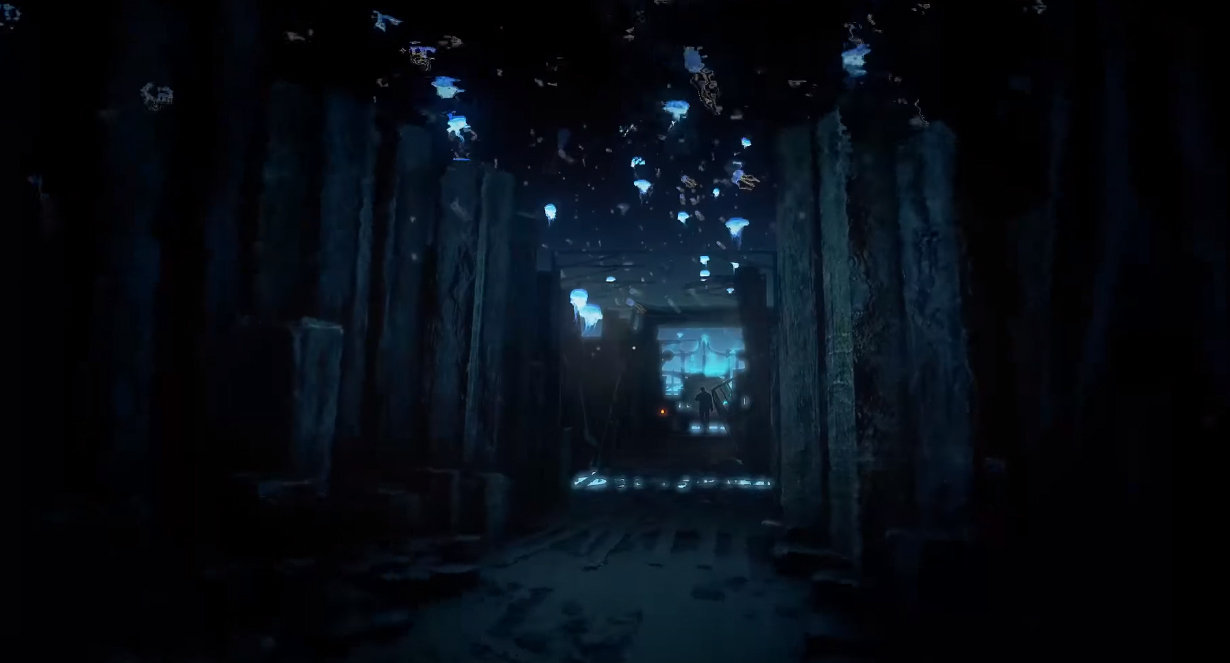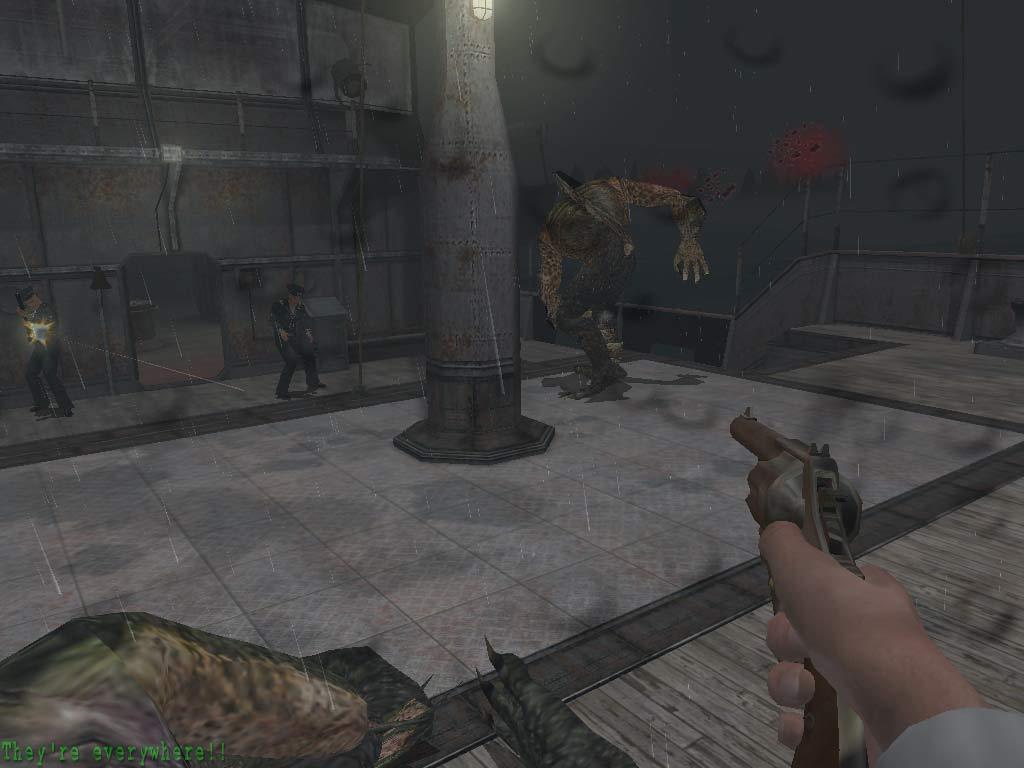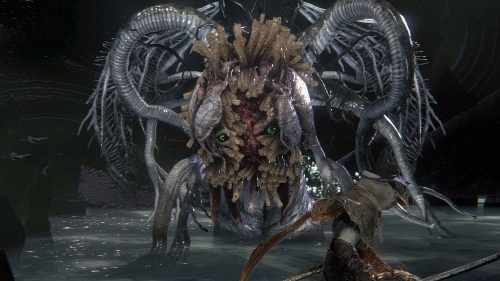This was a great indy experience that, like so many great indy projects, simply couldn’t push past a lack of funding. I was brought on-board to head narrative and contribute to level design once the narrative was complete. Keep in mind this is a project halted in the middle of development. I developed a good deal of story content that I will share here, along with some of the reasoning that went with it.
This is a hasty-ish consolidation of personal notes, design documents, and recollections of information lost to a deleted Slack account.
We've been here before
What made In the Shadows of Madness (ITSOM) such a great idea was David Watts’ ability to embrace the subtle art required to create a true sense of dread. The premise wasn’t the hottest take on the subject matter; A continuation of Lovecraft’s At the Mountains of Madness, it followed the fate of Antarctic research facility Eden Station.
BAS Rothera, reference photo
If you’re a patron of horror games, especially indie horror games, your eyes are rolling so hard right now you might go blind. You've seen this game before. Everything here is something we’ve seen:
Antarctic research facility
Attempt to translate Lovecraft into a video game
Empty space with no physical NPCs
On most days, you’d be right. This fits the model of a run-of-the-mill indie game.
The antarctic research station is commonly used due to it’s ludonarratively convenient size. A small team can build a small area and no one could argue that it shouldn't be that way.
Lovecraft is well-known, but also died intestate, making all of his works public domain.
An empty space means no need for difficult NPC animation.
But I joined the team, without assurance of compensation, because Watts understood that we could do so much with so little.
And because he loved P.T.
What P.T. DID
P.T., Hallway
“The influence of the old house was unwholesome”
We weren’t going to make a P.T.-style Lovecraft game. While that’s not the worst idea in the world, we're talking more about what P.T. said than what it was. If you’re unfamiliar with P.T., please go check it out. Watch some playthroughs that don’t have commentary. In brief, Hideo Kojima and Guillermo Del Toro famously collaborated on a free tech demo for the Fox Engine as a teaser for the now cancelled Silent Hills. The game featured an empty starting room, a single hallway, and a small bathroom. The player would loop through the hallway, and the environment would change based on seemingly inscrutable triggers. The sense of dread created by P.T. cannot be overstated. It stands as my favorite horror game of all time.
P.T. was not terribly complicated in terms of construction. The story was expressed through environmental narrative and radio dialogue. The player's agency was limited to movement and an action key. The game itself was mostly triggers and environmental changes that ranged from the subtle to the horrifyingly vulgar. Its complexity came from attention to detail, the expression of an excellent story, and how progress was conditioned.
It was a proof of concept that said “As long as you pay attention and think things through, you didn’t need huge production costs to make something powerful and captivating.” And while I know we’re not Kojima and he had a whole studio and legendary film director at hand, it was still no less true.
Like some of the greatest horror films, a budget could be a boon.
HOW TO DO LOVECRAFT CORRECTLY
Howard Phillips Lovecraft
Many attempts have been made to capture the feelings evoked by H.P. Lovecraft's work in a video game. Many have stumbled on some consistent sticking points. Identifying those points was key to developing something notable.
When interpreting Lovecraft, we have to strike a balance between what is iconic and what is thematic. He’s known for so many things, but like Arthur Conan Doyle, many narrative elements are famous, but not nearly as prevalent as is imagined. Additionally, we had to identify what about Lovecraft simply doesn’t work in the modern age and what doesn't work in the medium of video games.
Monsters and otherworldly places
It's important to stipulate here that I'm speaking to games directly translating or working from the works of Lovecraft. Many games feature Lovecraftian elements, but mostly in how they design monsters and otherworldly places. They're a kind of new American folklore with its own unique imagery.



In my opinion, it’s the nadir of most Lovecraft games. Afraid the game might seem boring or pressured to make the title more “gamey”, a monster is revealed. The first act is usually dedicated to the mundanity of the known world, but by the second or third act we’re introduced to a cannon Lovecraftian horror or an otherworldly location. Any tension or dread we’ve been feeling drains away, replaced by the reinforcement that it's just a video game.
The monsters of Lovecraftian horror work because you're reading the story. The horrors are alluded to in the text and we engage with them on a vague, conceptual level. The dread occurs when we attempt to imagine their impossible forms. That nebulous vision in our mind is disturbing because of its incomplete nature. While not an exact analog, it is akin to the film concept of “not showing the monster” which forces the imagination to perceive a more personally terrifying threat.
In regards to the suspension of disbelief, video games are a double-edged sword. In film, the story happens at you. Your options are to watch, cover your eyes, or turn it off. As a player, your ability to control the pace of action can either draw you into the world or protect you from feeling anything about it at all.
High-minded, artsy BS aside, monsters have to be skillfully designed, rendered, and animated. Otherwise, the smallest hitch blows the entire effect. It’s a huge investment for something that could potentially ruin everything. Even the "otherworldly place" has similar faults in terms of production. So we decided, if you didn’t need it, get rid of it. If the player can destroy their dread of the menace by engaging with it, then we should deny them that ability. Instead of creating a bogeyman, we should instead focus on the player questioning their reality, the tension of unknowing, and make them as uncomfortable as we can without breaking the moment.
Mystery
Most Lovecraftian stories are mysteries. Protagonists are, functionally, detectives by profession or circumstance. It’s a classic way to lead the reader through the story and it fits the mechanics of a video game well. Most lovecraftian games include this as a core story mechanic.
But a good mystery leaves you constantly on the edge of understanding. If you took what you’re seeing, turned it, maybe reinterpreted it a little, you just might see how it all fits together. The best mysteries show that, when the truth is revealed, it was all there from the beginning. You only lacked the context to see it.
Revelation and Insanity
"The mad ambitions of knowledge and philosophy"
Many horror tales include a terrible fate for the investigator. The protagonist’s grisly end is a seeming punishment for an established trespass or, in the case of lazier stories, for giving a shit about anything and just being there. But a Lovecraftian mystery is different in one key regard. That the very act of knowing is itself is doorway to madness.
The primary theme running throughout the stories of Lovecraft is the threat posed by knowledge. At one extreme, it starts innocuously, with curiosity leading to something terrible. At the other end, there is knowledge so profound as to obliterate our concept of reality. Our fragile human minds shattered by the sheer force of revelation.
This path to insanity is most commonly driven by investigation. Something dark or eldritch occurs and someone attempts to understand what it is or how to overcome it. In seeking truth, they become open to the madness. If we’re to include this core device, then it would have to be integrated into the player's own investigation as gameplay.
GAME MECHANICS
“We shall either go mad from the revelation or flee from the light into the peace and safety of a new dark age.”
My purposed gameplay design was that exploration would lead the player further from a “happy ending”. In The Stanley Parable, doing what you're told leads the player to an ostensibly happy “Freedom Ending” where Stanley escapes and everything is fine. Further play sessions reveal numerous alternate paths that each have their own ending. This all serves the larger narrative that explains choice is an illusion and all endings are roughly meaningless due to predetermination.
In a similar mechanic, exploration and investigation (knowledge) lead to progressively “unhappy endings” (madness). The narrative would be built in such a way that there would be several “outs”, or places where the story could end, if the player decided not to continue the investigation. These outs wouldn’t be marked in any particular way to signal them as end states, but they would simply be narratively functional resolutions given to the player that would resolve an existing conflict, but leave many questions unanswered and other conflicts unresolved.
THIS IS WHERE IT GETS WEIRD
The more you need to know, the fewer opportunities are left for the player character to escape intact. YOU are the force that drives the her insane. Her rational mind will protest through dialogue, but she'll push on regardless because of you. It could be your need to know the truth, a desire to try and help the Eden crew, or it could be your thoughtless drive toward completionism that comes at the cost of her mind.
Expressions of Madness
Keeping the player in a state of paranoia is a primary goal. In order to rob them of perceived safety, the amount of madness the player character is experiencing would not be expressed numerically. It would be represented through various non-interface expressions that avoid quantification. An example would be changing the environment in mundane ways that are simple to achieve, are often indirect, but take advantage of the player meta experience. Subtle, but inevitably registered consciously or unconsciously depending on player attention.
We’re preying on the day-to-day occurrences that we shrug off. Things that could be explained away by the player as lazy level design or thoughtless environmental continuity, until they are eventually to pervasive to be dismissed.
Below are a few basic examples:
Low-Level Madness
People in photos change direction, expression, ethnicity, or gender
Objects change orientation (10% adjustments)
Emails and other written correspondence are altered but retain coherence and meaning, but context shifts subtly.
Player character begins to talk to herself, but triggered directly
Mid-Range Madness
Player character mutters to themselves at random intervals
Doors randomly lock for short duration
Objects randomly fall from shelves, exchange positions with other items
Inconsistent day-night cycles
Lights, computers, and other electronics change on/off states when player is not present
Profound Madness
Player character muttering includes darker subjects, such as self harm
Character silhouettes appear briefly, but only when the mouse pans quickly
Irregular heartbeats
Moments of disabled movement, reduced turn speeds, inverted controls
Subtle chromatic shifts to familiar environments
These would be rare and inconsistent. Taking away the player’s sense of control will connect them to the player character though a shared loss of agency.
Narrative
Madness, Mental Illness, and Player Expectation
"Denizens of the Invisible World"
Because many publishers are disinclined toward risky design elements, players have become overly comfortable with a number of narrative devices. With the rise of independent games, they’ve seen the more complex, but still familiar devices of film and television in their games. In some rare instances of genius, some indie developers have truly upended expectations and told stories that could only be told through video games.
The story of In the Shadows of Madness takes place in the late 2000’s, a time of gaining psychological progress where "madness" is an inappropriate term. An internal awareness of psychology allows the narrative to explain events in such a way that one could see them as Lovecraftian or as symptoms of a psychological illness.
Then there are the opinions of players at large. Some profoundly negative ones that would be easy to subvert. It’s easier to explain this in less academic terms. So you’ll have to forgive the more vulgar nature of the following:
Indie games brought an artfulness to gaming that some, mainly assholes, found deeply upsetting because it dealt with real issues and tried to made them think or feel. Excellent expressions of complex ideas are viewed as non-games.
That being said, these ideas worm their way into even the best of us. Setting up expectations of a game experience suddenly becoming realized as a metaphor for a social issue. That idea then feels like a trope, even if you consciously resist it. Gone Home and Firewatch are examples of this experience structure. Wonderful games that provided material for others to setup unfair expectations. So the best thing we can do with these expectations is f*** with them.
The investigation of ITSOM begins as a general mystery that evolves into a story about mental illness. We address real issues about stability, job expectations, lack of treatment, prejudice, fear of discovery, imposter syndrome, etc., and we address them respectfully. Once everyone is certain there is no monster and it's all a feelsy game about mental health issues that’s when we shift from legitimate mental health to Lovecraftian madness.
The antagonist (Shoggoth) exploits mental illness, using it as a gateway. Not only into the mind of the victim, but into the material world it's attempting to invade. It finds us where we’re weakest and abuses that invisible pain for it’s own end.
We tell a real story about the hardship of real issues and then treat them as legitimate issues by using them to invoke fear. Horror is only effective if it preys on our real vulnerabilities. These vulnerabilities can only feel authentic to a majority of players if they empathize with characters that have them first.
So there we have it. A way to subvert expectations and add some truly disturbing elements to our game about dread and psychological horror.
Development
Much of the writing I did on ITSOM was Story B, the "Fate of Eden Station". I wanted to write this story first so that it could then inform Story A (the player experience) in a more congruent and organic manner. I used RealtimeBoard to chart out the events and characters to keep the continuity of characters and events as tight as possible. I wanted the player to get to know the Eden crew so well that, as they uncovered the timeline, they could feel the inconsistencies created by the Shoggoth. The images above are taken from the board at the point production stopped, so many inconsistencies and half-baked thoughts still exist.
Preface
German research icebreaker the RV Polarstern, reference photo
Starting with a quick outline of the beginning of the game, we'll move on to Story-B.
April 14th, 2003, the winters season of the South Pole. No smartphones, and mostly analogue equipment which fits the theme and mood of the game. During winter seasons, research stations have minimal research staff, primarily tasked with maintenance.
APRIL 14TH, 2003
The American Research Vessel Howard Phillips, bound for British Antarctic Survey Station (BAS) Rothera, picks up a Distress Signal from BAS Eden.
The signal is determined to be automated.
A team of three volunteers is assembled.
Fair weather reports greenlight dispatch by helicopter.
As the team is in visual range of Eden Station, harsh weather conditions force a landing.
A member of the team suffers a minor head injury during the landing.
Climatologist Sarah Evans-Zhang departs on foot using a Handheld Receiver to track the Distress Signal.
Sarah finds the Distress Transmitter, following its power cable to Eden Station.
At Eden Station, Sarah can no longer pick up the Distress Signal, nor can she radio the helicopter or the research vessel.
Exploring the station, Sarah finds it well-maintained, but completely devoid of crew.
Eden Station had a winter population of 10.
Sarah attempts to initialize the Base Transmitter and determine the location of the Eden crew.
Story B - Background
Robert Falcon Scott's ill-fated Antarctic expedition, reference photo
Technically, the novella At the Mountains of Madness is the canonical backstory of In the Shadows of Madness. The events occurred as they did in that story and you can read the full story here. As far as the game goes, there are some supplemental story connections one can make if they read the original story, but they're not crucial.
The following is information gathered from numerous in-game sources such as interview tapes, emails, notes, books, and NPC dialogue.
(Note: I wish I could give this story in the game’s intended order, but I had to leave to work on Life is Strange: Before the Storm, so I never had a chance to cut the story and re-order it to unfold as a mystery. So we’re going to have to stick to a chronological reading.)
The Pabodie Expedition (1928-1940)
1928: The shadow falls once again
The Mountains of Madness cast their shadow into Antarctica. The Elder City, now home only to the formless Shoggoth, semi-materializes in our world. The Shoggoth remain trapped within, unable to leave the dimensional rift.
(More on how the shadow operates later)
1929: Pvt. Morgan Danforth is discharged from the United States Army
Diagnosed with “mental alienation”, as was common at the time, Danforth is considered unfit for duty and medically discharged.
1929: William Dyer joins the Pabodie Expedition
William Dyer, a geologist at Miskatonic University, is bitten by the adventuring bug of the age. While others are uncovering tombs in Egypt, or plunging into savage Africa, his destination is the great icy waste at the end of the world.
1930-31: The Pabodie Expedition begins, ends in tragedy
The Pabodie Expedition sets out from Boston on September 2nd, 1930. They land at McMurdo sound on November 9th, and then establish a further drilling station further south.
Professor Lake ventures across the main continent. On January 22nd 1931, he encounters a mountain range which surpasses anything seen before, and sets up camp at the base. There, he finds obelisks that contain the bodies of Elder Ones, who awake and slaughter the crew.
A team led by William Dyer and Danforth set out to investigate, and follow the trail of destruction to the city atop the mountains. They follow the Elder Ones into a series of caves, where they come face to face with a Shoggoth which chases them.
During their escape, Danforth’s mind is seized by the Shoggoth. While escaping the city by plane, his mind crumbles under the strain as the Shoggoth is torn away from him and back into the shadow. In the penumbra of the mountain’s shadow, Danforth catches glimpses of that world, enough to ensure a life of madness.
1931: Repercussions of the Pabodie Expedition
After returning, Dyer reports that Lake’s camp was lost in a snowstorm, while Danforth is committed to a mental institution. A follow up expedition is planned, headed by Starkweather and Moore.
1931-32: Dyer attempts to stop the Starkweather-Moore expedition
Privately and publicly, Dyer makes every attempt to warn Starkweather away from Antarctica.
Starkweather responds that Dyer’s revelations are fantasies cooked-up to sell some unannounced novel of Dyer’s fictional exploits and that Dyer wishes to dissuade him from his expedition so as not to expose him. He notes that the details of Dyer’s story do not add up, as the crew of the Arkham dispute the time he spent at the Mountains.
1933-34: Starkweather-Moore expedition is a success, finds no evidence of Dyer’s report
Upon his return, Starkweather receives little in way of public interest about his reports, having found nothing particularly impressive.
As public attention swiftly fades away from his accomplishment, Starkweather begins to publicly report on what he didn’t find. Specifically, no ancient city or monstrous goo. Rumors speculate about the ‘Lake incident’ and whether William Dyer was somehow negligent.
1935: Dyer joins the Australian Expedition
To escape his professional humiliation, Dyer joins Professor Peaslee in his search for similar ancient beings in the Great Desert in Australia. The expedition finds some evidence supporting Dyer’s reports of Antarctica, but not enough to regain his reputation.
1940: Dyer commits suicide
After years of alcoholism, the 65-year-old Dyer cannot reconcile what he’s seen. He begins to doubt himself, but cannot be taken seriously as an academic if he admits to fraud.
As the world goes to war for a second time, William Dyer points a Makarov revolver at his temple and pulls the trigger. Having never married, his personal effects - including his expedition logs - are donated to Miskatonic University.
Eden Station (1970-1975)
1972-1975: Construction of Eden Station is approved and completed
The Royal Antarctic Survey (RAS) approves construction of Eden Station to study geothermics and other concerns in Antarctica. Close participation with the nearby Russian station Vostok is planned, although political relations between the two countries remain difficult.
The station is built over several summers, with the final module completed in the summer of 1975.
Yan Dmitruk (1996-2001)
1996: Dyer’s personal journal is rediscovered
While working inventory as part of his Miskatonic University internship, Yan Dmitruk, an Archaeology graduate student, discovers the journals of William Dyer in the university archives.
An archaeologist himself, Yan finds certain details in Dyer’s journal that are consistent with discoveries made decades after his death. The internal consistency and elaborate nature of the story are fascinating, and Yan concludes that few could develop a fantasy so congruent.
1997: Dmitruk proposes antarctic expedition
At the end of his internship, Yan proposes an expedition funded by the university to retrace the steps of the Pabodie Expedition. But after 60 years, the university has not warmed to William Dyer’s claims; and numerous satellite surveys of the area have discovered no mythical mountain range. The proposal is denied.
1998: Dmitruk is suspended from Miskatonic University
Frustrated by the reasoning of the expeditionary board, Dmitruk is nearly expelled, but the punishment is reduced to suspension pending the completion of a psychotherapy program provided by the university.
2001: Dmitruk takes his findings to Saint Petersburg
Yan returns to his hometown of Saint Petersburg and shares his discoveries with the university. Scholars find the data fascinating; and with the fall of the Soviet Union still fresh in their minds, the ability to embarrass the British and American universities is too tempting to ignore.
With the Russian Vostok Station so close to Dmitruk’s estimated search area, there was little to invest. Formal approval was granted in 2002, with work planned in the Summer of 2003-2004.
2003: Dmitruk arrives at Vostok station
Dmitruk’s work is considered a waste of valuable resources by the Russian scientists of Vostok Station. This is exacerbated when the station cook finds the Dee’s translation of the Necronomicon (Penguin Edition) in Dmitruk’s luggage, accusing him of being a fraud and a “ghost chaser”.
STORY B - THE FATE OF EDEN STATION
Crew of Eden Station, reference photos
Discovering the fate of Eden Station would be 50%-70% of ITSOM's narrative depending on production scope. From her base in communication room, Sarah Evans-Zhang would re-purpose an existing bulletin board into something of narrative murder-board, not too dissimilar from the one I used to develop the story. Given the complex mystery, a visual representation is helpful.
2003: The shadow falls over Vostok
In late December, Vostok goes radio silent.
2004: Vostok survivors arrive at Eden Station
During a winter storm, two men are found near the Eden Station perimeter by station Electrician Cyrus Milanowski during a routine maintenance check.
Brought into Eden Station, they are treated by station Doctor Kathleen Hjelmstad.
During the examination, their personal effects are examined by Station Leader Samantha Fitzpatrick. In a backpack carried by the older man are:
Two ID’s
A copy of The Necronomicon, Dee Translation (Penguin Edition)
A Leather-bound Journal attributed to William Dyer
A Makarov 18mm pistol (Identified by Milanowski)
4 of 8 rounds remain in the clip
Hjelmstad translates the Russian IDs.
The two men are Vostok Station machinist Grigori Lazarev and researcher Yan Dmitruk.
During treatment, Hjelmstad asks a number of medical questions. Lazarev replies in a dialect the doctor doesn’t understand, while Dmitruk says nothing.
Fitzpatrick attempts to interview Lazarev, but Hjelmstad can only make out bits and pieces.
Hjelmstad’s diagnosis is exposure, some kind of trauma, and what looks like physical abuse.
Hjelmstad begins taking notes of the event.
Fitzpatrick has the survivors quarantined in an empty bunk and orders blood work to check for communicable diseases.
IT & Communications Manager James Vince reports that comms are down. Cause unknown.
Milanowski and Vince check the comm systems for fault, but can’t determine the source of the outage.
A heated argument breaks out between the two over who's to blame.
At roughly the same time as the argument, Hjelmstad begins processing Lazarev’s blood, she returns to quarantine with orange juice.
Dmitruk is found missing.
Dmitruk’s Clothes are stacked neatly next to Lazarev.
Fitzpatrick questions the crew.
No one saw Dmitruk leave. No one can remember who last entered quarantine or if the door was locked at any time.
Returning to the lab, Hjelmstad finds Dmitruk’s Blood Sample is missing.
Fitzpatrick orders a search of the entire facility.
No trace of Dmitruk can be found.
Fitzpatrick begins interrogating the Eden Station crew, except for Vince and Milanowski who were in comms at the time.
Where were you when the radio blackout started?
Carpenter Daniel Sky: Asleep in his bunk. No witnesses.
Mechanic Vivian “Viv” Battersby: Repairing the kitchen stove in the Mess Hall. Shipley and Driver can vouch for her.
Plumber Drew Shipley: Drinking in the Mess Hall. Mess Hallcan vouch for him.
Physicist Jackie Quinn: Taking readings in the Magnetics Lab. Carmichael saw her come back to the Habitat Pod.
Cook Derek Driver: Working on the stove with Battersby.
Doctor Kathleen Hjelmstad: In the common room watching a movie until called for treatment. No witnesses.
Field Assistant Shelly Carmichael: Pacing around the habitat. Witnessed by several people.
Where were you when Dmitruk disappeared?
Carpenter Daniel Sky: Asleep in his bunk. No witnesses.
Mechanic Vivian “Viv” Battersby: In her bunk. Witnessed by Quinn.
Plumber Drew Shipley: Fixing a toilet. Witnessed by Milanowski.
Physicist Jackie Quinn: In her bunk. Witnessed by Battersby.
Cook Derek Driver: Cleaning the kitchen. No witnesses
Doctor Kathleen Hjelmstad: Running blood tests. Witnessed by Fitzpatrick.
Field Assistant Shelly Carmichael: Pacing around the habitat. Witnessed by several people.
Vince and Milanowski attempt to boost the signal strength on comms, receive Unknown Transmission.
Quinn listens to the Lazarev interview tape.
Vince and Milanowski attempt to filter the Unknown Transmission, but fail to do so.
Gregori Lazarev succumbs to his injuries and dies.
Hjelmstad performs an autopsy on Gregori Lazarev.
She finds many old scars and poorly knitted bone fractures.
Eden Station begins to suffer brownouts.
After nearly a week after Radio Blackout, Shipley and Sky volunteer to take one of the two SnowCats and a transmitter out toward Vostak, the closest station by a significant degree. Fitzpatrick requests they take the Makarov Pistol, they refuse on concerns of appearing hostile.
Quinn requests to examine the books brought by the survivors to check for anything relevant. The request is approved.
In the common area, Quinn posits that Aliens could be to blame, which results in heated argument with Battersby.
Concerned about the situation and morale, Fitzpatrick orders a full inventory of what at the station works and what doesn’t.
Battersby is sent to the Mess Hall to meet Driver and take inventory of food supplies.
Battersby spends most of the time complaining about Quinn. Irritated, Driver asks Battersby to take a few meals to the Habitat Pod.
Battersby never arrives at the Habitat Pod.
Vince is ordered to examine the limited video surveillance available.
After several hours, going over thousands of grainy stills from external webcams, Vince finds a single still image that appears to depict a naked Daniel Sky outside the Mess Hall.
Hjelmstad and Carmichael are ordered to inventory the the sickbay.
Behind the centrifuge, Carmichael finds the Broken Test Tube.
Hjelmstad identifies it as Dmitruk’s blood sample, but no trace of blood can be found.
At this news, Carmichael suffers a panic attack. Later confessing to an undisclosed anxiety disorder.
Hjelmstad orders Carmichael to take bed rest. Gives her a mild sedative.
Carmichael reports a seeing a naked Shipley walking through the habitat, but she can’t be sure if it was a just dream.
Milanowski is ordered to check the generators. Reports back that all generators are operational.
Quinn checks the Magnetics Lab for anything helpful.
Vince reports his findings to Fitzpatrick.
Fitzpatrick shares Vince’s findings with only Hjelmstad to avoid panic.
Hjelmstad relates the contents of Carmichael’s dream to Fitzpatrick.
Driver returns to the Habitat Pod. Is asked why no meals have been brought out, responds that he sent them with Battersby hours ago.
Fitzpatrick orders the habitat locked down, attempts a census:
BATTERSBY: MISSING
DANIEL SKY: SUPPLY RUN, HAS NOT RETURNED
DREW SHIPLEY: SUPPLY RUN: HAS NOT RETURNED
JACKIE QUINN: MAGNETICS LAB
JAMES VINCE: PRESENT
CYRUS MILANOWSKI: PRESENT
KATHLEEN HJELMSTAD: PRESENT
SHELLY CARMICHAEL: PRESENT
DEREK DRIVER: PRESENT
Concerned about the storm, Carmichael can’t remember if she’s actually seen daylight since the Russians arrived.
During requested medical exams, the crew report vividly disturbing dreams, but these are likely due to the isolation of the lock-down.
Food is rationed.
After unknown number of days, someone, possibly Daniel Sky, begins frantically banging on the habitat door. He screams variations of “Help me!” in English then in Russian. Fitzpatrick orders the door remain locked, there is distension about letting him in, but during the argument the man disappears.
Hjelmstad notes that people are sleeping longer.
Food is rationed further.
Milanowski wakes from his bunk believing Carmichael is calling his name.
Fitzpatrick finds Milanowski mumbling incoherently over Carmichael’s corpse. She’s been strangled to death.
Fitzpatrick orders Milanowski out of the Habitat Pod at gunpoint.
Milanowski dies of exposure trying to force himself back into the Habitat Pod.
Driver, against orders, returns to the Mess Hall.
Driver turns up the heater and enters a deep sleep.
After 36 hours the heater shorts.
Driver dies of hypothermia in his sleep.
Hjelmstad begins working on methods to endure the stress through various medical procedures and therapies. Unknown time passes and her methods lose cohesion as she begins experimenting in ways that mirror alchemy and other forms of mysticism. Vince finder her dead in the Sickbay.
After finding Hjelmstad, Vince enters a complete prophetic fit. In attempting to find meaning in the madness he rewrites Dyer’s journal in Russian. Upon completing it, he takes the Makarov Pistol and commits suicide in the same manner as William Dyer.
Completely alone, Fitzpatrick opens the door to the Habitat Pod and walks out into the storm.
STORY A - IN THE SHADOWS OF MADNESS
As I said before, I had to leave the project before fully developing the A-story and the manner of how the B-Story is uncovered, including the many possible fates of Sarah Evans-Zhang. After my departure the project, it ground to a halt and was abandoned.
The initial plan was that examining the records and environment of Eden Station would reveal a number stories wherein characters dealt with mental illness and the stresses of living in such unusual conditions. This would then evolve into the Lovecraft narrative as, while interesting and satisfying, none of it would actually explain where the hell anyone went.
Once we cross the threshold wherein the player has decided to stay and investigate rather than leave the station, we introduce a vocal NPC. Sarah receives a radio transmission from Station Leader Sarah Fitzpatrick. Explaining that she is locked inside the unexplored Magnetics Lab, she would make a number of excuses as to what happened to the station crew involving a hitherto unknown system of caves. A more defined story was not developed at this point.
In reality, there is no system of caves. Sarah is running our Sarah from task to task to break her down and make the environment more conducive to the Shoggoth. As Evans-Zhang performs theses tasks, she has more opportunities to investigate areas of the station she couldn't before as Fitzpatrick gives her access codes and other information she couldn't have found herself. At first, her help will seem suspicious, but suspicion would be misdirected through empathy as she explains her struggles with mental illness.
At some point down the line, Evans-Zhang would be able to see Fitzpatrick. While age appropriate, keen players will note that she does not fit Fitzpatrick's description. This is the threshold where the player could definitively believe they don't know what's really going on.
WHAT'S REALLY GOING ON
From Twin Peaks, to LOST, to Battlestar Galactica, I've had an allergy to stories where the truth is not truly known to the writer. Often they write as they go along and attempt to fill in details or inconsistencies later. I wanted to know, from the beginning, what was happening, even if we didn't ever explicitly tell the player.
SHOGGOTH
An interpretation of Lovecraft's Shoggoth that we would not be using
In At the Shadows of Madness, the Elder Things use the Shoggoth as an amorphous slave race. What the Elder Things did on Earth or what they had planned is never clearly revealed, but it happened at such a prehistoric time that it barely matters. What does matter is that the Shoggoth revolted and destroyed their masters. Beings of inconsistent intelligence, they inadvertently trapped themselves here, having no understanding as how to return to their home realm or cross over onto Earth.
The Shadow of madness
To explain why no trace of the Elder Things was ever found after the Pabodie Expedition, even after the advent of satellite photography, is that the Mountains of Madness are not in this world. The Elder Things built the mountains in their own realm. These artifices cast a "shadow" into other realms allowing the Elder Things and their servant Shoggoth to explore without technically leaving the safety of their world. A shade of the target destination would occur and time their would occur outside of normal time, allowing the Elder Things to work in safety as the rest of the target world would be mostly unaware of their presence as years would pass in hours.
The Shadow is cast by the Elder Things to whom it is anchored. When the shadow is recalled, the Elder Thing is recalled with it. The Shadow and the Elder Thing exist separate from the mountain, meaning that an operator is required to return. Once the Elder Things had been destroyed by the Shoggoth, the Shadow had nothing to moor itself to a specific location. The minds of the Elder Things, deep and unknowable, are as madness to us. In that madness, the Shadow is called.
As millennia passed, the Shoggoths realized they could not call the shadow, but that certain people could move it. Those human beings of troubled minds called the shadow to them. The greater the madness, the greater the call. Thus, as expeditions came and went, the Shoggoth attempted to twist the minds it found to bridge the gap between our world and their own.
Jackie Quinn
The Shoggoth, eternal beings, are patient. Attempts are made, but they fail until the arrival of Yan Dmitruk at Vostok Station. The Shoggoth torment Yan until he is attuned enough to the shadow that one of the Shoggoth can inhabit him, consume him, and then take his form. They cannot, however, attune the other inhabitants of Vostok who die in the attempt. Yan leaves Vostok with one catatonic survivor and arrive at Eden Station.
Here they take a more sublte approach, learning much from the trials of Vostok. Like Yan Dmitruk, the Shoggoth found a vulnerable mind in Jackie Quinn. A physicist, her perception of the universe and history of mental illness gave them a door from which to slowly alter the world around her. The crew of Eden station is slowly, deliberately tormented by the Shoggoth as Jackie is kept safe in the Magnetics Lab. The crew barely perceives the years as they go by within the Shadow.
By the time Sarah Evans-Zhang arrives, it's been nearly ten years that have passed in the span of three days outside the Shadow. Her age requires her to impersonate the station leader, Sarah Fitzpatrick. Jackie needs Evans-Zhang to make changes to the station that are beyond her knowledge, but that will help widen the scope of the Shadow significantly. There are untold Shoggoth who desire access to our world and they're unwilling to waste Jackie Quinn to bring only one Shoggoth into the world.
And at that's about it
There was more we considered doing and huge amount of supporting content to help the player get to know the Eden crew. Some of it was developed, like the individual Eden characters, but not included here because, if you've gotten this far, you're in the minority and wow there is already too much content on this page.
All in all, I really wish we could have developed it. Maybe elements of In the Shadows of Madness will show up in games I develop down the line. If you're confused about anything here, hit me up on twitter @Christoph_Means, and I'll try to clear it up if I can.













